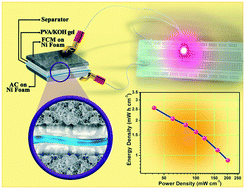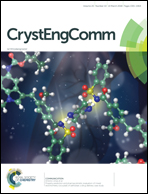Flower-like Cu2NiSnS4 microspheres for application as electrodes of asymmetric supercapacitors endowed with high energy density†
Abstract
Design of electrode materials for supercapacitors using earth-abundant and less-toxic metals is both cost effective and environmentally benign. The present study deals with the synthesis of flower-like Cu2NiSnS4 microspheres (FCMs) and utilizing the same as positive electrodes of solid-state asymmetric supercapacitors. Citric acid was used for the synthesis of Cu2NiSnS4 as the structure directing agent; a possible growth mechanism of the formation of flower-like microspheres is proposed. The as-prepared FCMs on nickel foam demonstrated a high specific capacitance of 1639 F g−1 at a scan rate of 5 mV s−1. The as-fabricated solid-state asymmetric device achieved high values of volumetric (8.81 F cm−3) and gravimetric (105.7 F g−1) capacitances. The device attained the maximum energy density of 2.57 mW h cm−3/30.88 W h kg−1 and high power density of 201.4 mW cm−3/2.42 kW kg−1. Superior capacitance retention of the device was confirmed as it maintained 95.7% of the initial capacitance after 2000 cycles. Thus, by effective integration on a large-scale basis, these supercapacitors have great potential for the development of sustainable energy storage systems using low-cost earth-abundant materials.



 Please wait while we load your content...
Please wait while we load your content...